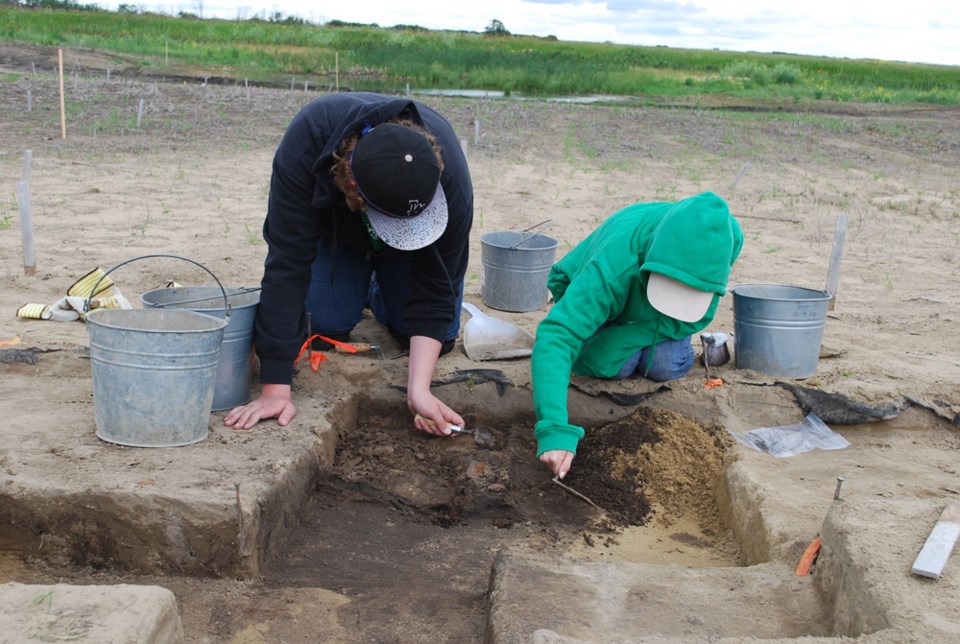The archaeological dig at the Original Humboldt site has come to a close for another year with Humboldt Museum staff, archaeologists with Western Heritage in Saskatoon, and members of the public digging for relics.
This year, the dig focused on finding remnants from the approximately 100 soldiers who camped at the site during the North-West rebellion. The site is also important because it held the Humboldt telegraph station, which was built by the Dominion of Canada as part of a telegraph line that would follow the route of the Canadian Pacific Railway (CPR). The museum has plans to build a replica of the telegraph line later this year.
The story goes that Sir Frederick Middleton and his troops were heading west to Manitoba when Middleton heard about a fight between North West Mounted Police and a Metis force led by Gabriel Dumont. He then decided to head north from Fort Qu’Appelle to Batoche. The group rested for a few days in Humboldt, and then continued on. Later, a force led by Lt. Colonel George T. Denison received orders to march to Humboldt. He and his men guarded food stores and went on horseback to and from Middleton with information.
“We were like the supply depot and communications depot for the North West resistance,” said Jennifer Hoesgen, executive director of the Humboldt & District Museum and Gallery. “If you read all the newspaper articles from 1885 back east, the dispatches are coming from Humboldt because a lot of time, the line further up was cut.”
The Original Humboldt site utilizes public archaeology, meaning any interested parties can come out and help. The experienced archaeologists will do anything technical, including geophysics (ground penetrating radar to see what’s under the soil) as well as magnetometer surveys, which are used to map archaeological features. The public helps uncover relics and screen the soil in the area.
“We’re not as stringent as professional archaeologists because most of the people don’t have any experience in that field,” Hoesgen said.
In the past, the dig has attracted people from B.C. and even one woman from the U.K. who was visiting relatives and happened to drive by.
“(She) was visiting her relatives so she came out the next day to help us excavate because she figured this would be her once in a lifetime opportunity to excavate,” Hoesgen said.
People digging at the site found a lot of food cans, which likely contained foods like corned beef, head cheese, and tongue. The group also found a belt buckle and some leather.
“You’re looking at a time when that could be a soldier’s from 1885,” Hoesgen said.
The finds will be taken back to Saskatoon for archaeologists to clean them up and test them, and Hoesgen will receive a written report with the findings in the early spring.
“A lot of the time, you can’t tell in the field because they look so bad,” she said.
The big find this summer was an intact medicine bottle. Hoesgen said they also found wire in the food cans, which they haven’t seen before.
They don’t have any concrete goals in mind for the site, but they are trying to find refuse pits. The soldiers would have kept a clean camp and dumped their garbage all in one place.
“It’s good for us that they dump it in one location. That works really well. It’s really convenient,” she said.
The site is so large that Hoesgen can’t say for sure when there will be a point where there’s nothing else to find.
“Every time we learn more, we seem to need to know more. Because we really don’t know exactly what the extent of the site was,” she said. “What we’re finding now is … there’s a lot of activity outside that main area, so we’re expanding our geophysics out to see.”
As for next year’s goals, that’s up in the air until the report comes.
“It depends on what they find,” Hoesgen said. “Then we say ‘What did we find and what are the goals for next excavation summer?’”
While the site is obviously archaeologically significant, it also is important to the community of Humboldt itself.
“We really want local children and students to understand that the history and development of Canada is so close to them,” she said. “For us to say the North West Resistance of 1885, which was so important to Canadian history, happened right outside our door, that’s not an opportunity a lot of people get.”




